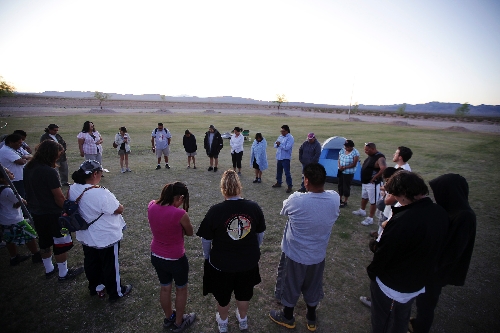NV Energy’s coal-burning plant fires up Paiutes
They left as the sun rose over the reservation and cast a shadow on the coal-fired power plant's four stacks that jut from the Moapa Valley desert floor.
More than 20 members of the Moapa Band of Paiutes and other tribes from Nevada, Utah and Arizona trudged over rocky trails and a dirt road that cuts across federal trust lands that have belonged to the Paiutes since 1875 and where they lived for centuries before that.
The road parallels railroad tracks that carry the coal to NV Energy's Reid Gardner 557-megawatt power station. The plant is a source of electricity for 335,000 homes, 50 miles away in Las Vegas.
It also is the source of air pollution and coal-ash from the power-generation process, a toxic mix of fine particles that the 300-member Moapa band blames for myriad health problems that have taken a toll on the tribe since the power plant began operating in 1965.
Paiutes tell stories of the plant's impact over four decades. On windy days, coal-ash particles from the plant's landfill fell like snowflakes on houses at the reservation where about half the tribe lives. On stagnant mornings, yellow-brown clouds hovered over the reservation and the rotten-egg smell of hydrogen sulfide from evaporation ponds drifted across the valley.
That is why this group of American Indians embarked on a "cultural healing walk," a three-day, 50-mile pilgrimage that ended at the Lloyd George U.S. Courthouse in Las Vegas on Earth Day. Their goal was to raise awareness about health problems the Moapa band faces from continued operation of the Reid Gardner Generating Station.
Lee Swan, a 64-year-old Southern Paiute, sees a monster in the tallest of four smokestacks, built in 1983 and standing 500 feet. The other three, constructed in the 1960s and '70s, are about half that height.
"It's like a big giant laughing at us. So this walk is to make people listen because we're being ignored. Our people are dying," said Swan, a Vietnam War veteran whose brother worked at the Reid Gardner plant and died from an enlarged heart at age 32.
Heart disease and respiratory problems are some of the illnesses that have affected the Moapa Band of Paiutes and have resulted in premature deaths, said Vickie Simmons, a member of the band's Environmental Committee and Health Board who organized the healing walk. Other ailments include asthma, thyroid failure, anxiety attacks, migraine headaches, lupus and accelerated diabetes.
"We're dying faster than all the other Southern Paiute tribes," she said.
AIRING THE ISSUE
The Environmental Protection Agency will hold hearings Thursday at the reservation and in Overton. EPA officials will field comments on a proposed rule to allow NV Energy to install new emission controls at the Reid Gardner Generating Station, but the Sierra Club and the Moapa band complain that the system of nitrogen oxide burners is not the best available technology for reducing haze and meeting Clean Air Act requirements.
Instead of a "second-rate solution" for stack emissions, as Jane Feldman, conservation chairwoman for the Sierra Club in Southern Nevada, calls it, they prefer a more expensive technology known as selective catalytic reduction.
But company officials say that would cost "hundreds of millions of dollars," enough that it might make economic sense to shut down the plant altogether.
COMPANY CLEANUP
"NV Energy will continue its commitment to operate the Reid Gardner Generating Station in the best interests of its customers, in compliance with all federal and state laws, and in an environmentally responsible manner," company spokesman Mark Severts wrote in an email last week when asked about NV Energy's reaction to the cultural healing walk.
He offered an example of how the company is trying to make the coal-fired plant more compatible with the environment.
"One of our current environmental efforts is moving existing evaporation ponds farther away from the Muddy River floodplain. This project moves the ponds nearly two miles farther away and will further mitigate any dust or odor concerns," Severts said.
He noted that the Reid Gardner station has made strides on the environmental front:
■ Pollution controls now capture 99.9 percent of all particulate emissions.
■ The station's high-efficiency scrubbing systems have put Reid Gardner among the top 10 percent of plants in the nation for low-sulfur emissions that result from burning coal for creating steam to run turbines that generate electricity.
■ The company has installed landfill lining systems that exceed state and federal requirements, and is now rated as a zero-liquid-discharge facility.
■ The plant's nitrogen oxide emissions are less than power plants of similar age.
But that hasn't always been the case, prompting the Sierra Club to team up with the Moapa Band of Paiutes on legal and administrative challenges to the plant's continued operation.
Last year, the Southern Nevada Health District's board approved a permit for NV Energy to expand the Reid Gardner landfill, paving the way for 35 more years of operating the plant over objections from the Paiutes and environmentalists. A Sierra Club lawyer, Dan Galpern, argued that the board acted without knowing that a computer model by an NV Energy consultant showed that significant contamination - millions of gallons - would continue to escape from the existing landfill with more coming from its expansion on a nearby mesa even if it's built with a protective liner on part of it.
Galpern unsuccessfully urged the health board to rescind its approval of the company's permit application for the landfill expansion and to close the existing landfill to prevent a number of toxic metals and coal-ash compounds from polluting state waters.
Contamination from the plant's existing landfill, including a cancer-causing chromium compound known as hexavalent chromium, has seeped into groundwater that feeds springs and the Muddy River. The river flows into Lake Mead, Southern Nevada's primary drinking water supply.
The company asserts, however, that groundwater samples near the landfill and samples from the Muddy River show the total amount of chromium is below the federal drinking water standard and that hexavalent chromium would be even lower.
Nevertheless, in 2009 the EPA's toxic release inventory showed the Reid Gardner power plant released 169 pounds of chromium into the air, and 48,262 pounds were put in the station's coal-ash landfill.
The Sierra Club and the Moapa Band of Paiutes sued the Bureau of Land Management for granting a right of way to expand the landfill on public land, and NV Energy intervened on behalf of the BLM. The U.S. District Court in Las Vegas ruled against the challenge by the tribe and the Sierra Club, but they recently appealed to the 9th U.S. Circuit Court of Appeals in San Francisco to overturn the district court decision. Meanwhile, the 9th Circuit Court denied the Paiute band and the environmental group's request for a preliminary injunction to stop the landfill's construction.
In his statement last week, Severts, the NV Energy spokesman, said, "We believe the Sierra Club's national agenda is self-serving and potentially causing unintended negative consequences to our Moapa Band neighbors and the Muddy River floodplain."
ON THE TRAIL
Tyler Samson, a 25-year-old Moapa Paiute, carried the band's yellow-and-maroon flag from start to finish of the cultural healing walk.
"To me it's a way to show what we represent and a way to stand up for what's right," he said.
"It raises awareness for other people to realize what's going on with the power plant being so close to the reservation.
"It's a place we all hold sacred, and we want to keep this earth healthy," he said.
Walking beside him and carrying the U.S. flag was Army veteran David Lee, 32, a member of the Moapa band and Goshute tribe.
"The walk is a powerful statement," said Lee, whose grandmother, Evelyn Samalar, of the Moapa band, died from lymphoma three years ago.
"Future generations will look back and say, 'Hey, they did that for us. They stood up against the power plant.' "
Robert Pete Sr. traveled from Cedar City, Utah, to join the walkers. He carried a staff with eagle feathers.
"We need to protect this land. Everything on this land has a story. Under each rock and bush there's a story about our ancestors and when it gets disturbed, it's gone," said Pete, 53, of the Cedar Band of Paiutes.
At the end of the walk on April 22, Moapa Band of Paiutes Chairman William Anderson addressed a crowd of more than 100 members of Southwest tribes and supporters from the Sierra Club who had rallied on the sidewalk in front of the federal courthouse. By midafternoon the temperature had almost reached 100 degrees.
"This is about our tribe, our people," he said about the band's effort to replace the Reid Gardner station with a clean, solar energy plant.
"It's affecting our people, our culture, our heritage. It's tearing us apart."
Contact reporter Keith Rogers at krogers@reviewjournal.com or 702-383-0308.
EPA HEARINGS
The Environmental Protection Agency will hold two public hearings Thursday on retrofitting NV Energy's coal-fired Reid Gardner Generating Station with systems to reduce haze and improve visibility in national parks and wilderness areas.
The first hearing will be from 1 to 4 p.m. in the auditorium of the Moapa Band of Paiutes administration building, 1 Lincoln Street at Reservation Road near Moapa. An open house will precede the hearing from 11:30 a.m. to 12:30 p.m.
The second hearing will begin 6:30 p.m. in the Ron Dalley Theater of Moapa Valley Empowerment High School, 2400 St. Joseph Street in Overton. An open house will precede the hearing from 5 to 6 p.m.






















